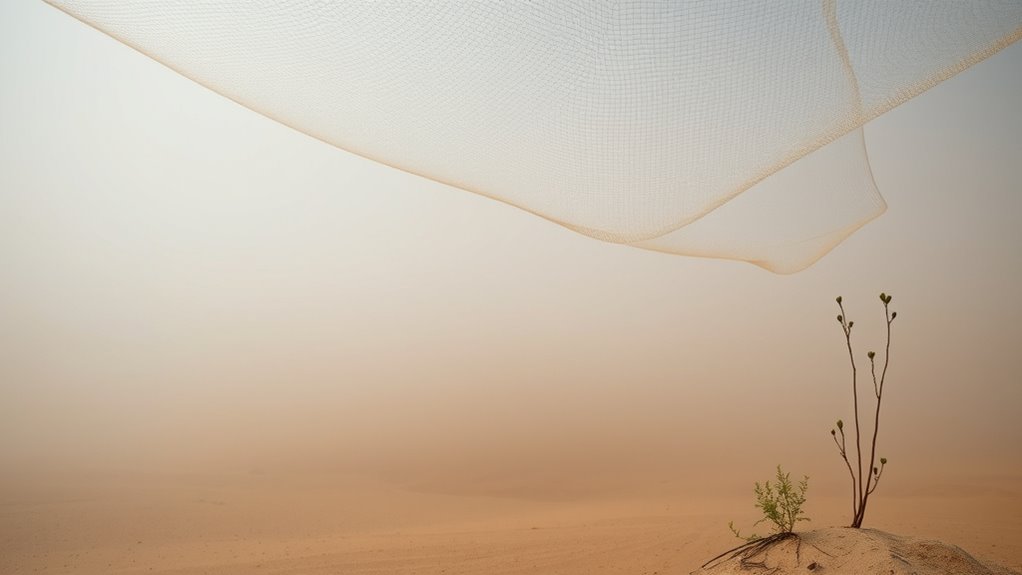Fog-harvesting meshes allow you to turn arid deserts into green landscapes by capturing moisture from fog. These nets, made from specialized materials, collect tiny droplets that coalesce and drain into storage systems, providing water for irrigation and ecosystems. Their effectiveness depends on climate, terrain, and design. When optimized, they can markedly boost local vegetation and sustainability efforts. Keep exploring how these innovative systems are transforming desert environments and helping communities thrive.
Key Takeaways
- Fog-harvesting meshes can transform arid deserts into green zones by providing a sustainable water source.
- Proper mesh design and placement maximize water collection, supporting desert greening efforts.
- Coastal dry regions with persistent fog are ideal locations for deploying fog-harvesting systems.
- Fog harvesting promotes ecological restoration, agriculture, and local livelihoods in desert environments.
- Combining fog meshes with other sustainable practices enhances desert greening and climate resilience.

In arid deserts where water is scarce, fog-harvesting meshes offer a sustainable solution to support desert greening efforts. These systems use fine mesh nets mounted on poles to capture moisture from fog, turning it into drinkable water without needing electricity or fuel. As fog droplets collide with the mesh surface, they coalesce into larger droplets that drain down via gravity into storage tanks, providing a reliable water source. The design and material of the mesh are vital; factors like fiber size, spacing, and wettability considerably impact how much water you can collect. Because the process is passive, inexpensive to set up, and environmentally friendly, it’s an attractive option for regions struggling with water scarcity. Research indicates that with proper maintenance, fog nets can operate effectively for many years, making them a durable solution for long-term desert greening. The efficiency of fog harvesting varies depending on climatic conditions and geographic location. For example, in Alto Hospicio, Chile, a fog collection system covering around 38.61 square miles can produce between 0.05 and 1.32 gallons (roughly 0.19 to 5 liters) of water per square meter daily—peaking during the colder months of August and September. Similarly, Morocco’s Dar Si Hmad project harvests about 10 liters of water per square meter, doubling the previous global average of 5 liters per square meter. Optimizing mesh geometry and surface chemistry can boost efficiency by up to 500%, making the process even more effective. Keep in mind, water yield heavily depends on fog density, wind speed, and persistence, so choosing the right location and strategic placement—like hilltops or valleys—ensures gravity helps transport the water efficiently to storage and irrigation points. Successful fog harvesting requires specific geographic features such as elevated landforms, consistent wind patterns, and regular fog occurrence. Coastal dry regions with persistent fog, like northern Chile and Morocco’s Ait Baamrane region, are ideal for deploying these systems. If your area experiences recurrent droughts and has limited surface water, fog harvesting could provide a critical water source for irrigation and ecosystem restoration. However, not every desert or dry area qualifies; you need to carefully evaluate the local climate and terrain to determine suitability before installing these systems. When properly implemented, fog-harvesting meshes can transform arid landscapes into greener, more sustainable environments. This technology does more than just provide water; it empowers communities by enabling them to irrigate crops, support local livelihoods, and restore ecological balance. It supplies potable water to remote settlements disconnected from traditional infrastructure, helping to combat water scarcity and improve food security. Additionally, it encourages sustainable farming practices rooted in local knowledge and conservation. As climate variability increases, understanding the climatic factors influencing fog formation is essential for optimizing system placement and efficiency. As a flexible and scalable solution, fog harvesting also serves as a platform for scientific research on climate adaptation, offering insights into sustainable water management strategies for some of the world’s most vulnerable regions.
Frequently Asked Questions
How Durable Are Fog-Harvesting Meshes in Extreme Weather Conditions?
You might wonder how well fog-harvesting meshes hold up in extreme weather. Their durability depends on material choice and design. Metal and coated meshes, especially stainless steel with protective layers, resist wind, UV, and chemical damage better than simple polymer meshes. Structures like 3D and multi-layer designs distribute stress more evenly, extending lifespan. With proper selection, these meshes can withstand harsh conditions and continue functioning efficiently over time.
What Is the Cost Comparison Between Fog Harvesting and Traditional Irrigation?
You’re wondering how the costs of fog harvesting compare to traditional irrigation. Fog harvesting involves low upfront costs—$75 to $1,500 for collectors—and minimal ongoing expenses since it’s passive and energy-free. Traditional irrigation requires significant investments in infrastructure, pumps, and ongoing energy costs. Overall, fog harvesting is more affordable for small-scale, arid-region projects, making it a cost-effective, sustainable alternative to traditional irrigation, especially where water sources are limited.
Can Fog-Harvesting Meshes Be Reused or Recycled After Lifespan?
You’re wondering if fog-harvesting meshes can be reused or recycled after their lifespan. Recycled PET meshes perform well over multiple uses with proper cleaning, maintaining efficiency. They can also be reprocessed into new products at end-of-life, supporting circular recycling. While environmental factors affect durability, using recycled materials reduces costs and environmental impacts. However, contamination and coating challenges may limit reuse and recycling, so ongoing research aims to improve these processes.
How Does Fog Harvesting Impact Local Ecosystems and Wildlife?
You might wonder how fog harvesting affects ecosystems and wildlife. It increases water availability, reviving desertified land and supporting plant growth, which benefits local animals by providing food and shelter. This new environment can attract more wildlife, enhance biodiversity, and protect vulnerable species. However, you should also consider potential disruptions, like changes in fog flow or microclimates, which could impact sensitive desert species if not carefully managed.
Are There Specific Regions Where Fog Harvesting Is Most Effective?
You’ll find fog harvesting most effective in arid, semi-arid, coastal, and mountainous regions where moist air meets cold surfaces. Places like coastal Chile, Oman, and Saudi Arabia benefit from long fog seasons, strong winds, and high altitude. These conditions create frequent fog, boosting collection rates. If you’re considering fog harvesting, target areas with consistent fog presence, favorable wind patterns, and terrain that exposes meshes to airflow for ideal water collection.
Conclusion
Imagine turning barren deserts into lush oases, where fog-harvesting meshes act as silent gardeners whispering promises of green. With each droplet caught, you’re weaving a tapestry of hope and renewal, transforming arid wastelands into thriving landscapes. By harnessing nature’s gentle mist, you become a steward of change, planting seeds of sustainability. Embrace this innovative marvel and watch as the desert breathes anew, blossoming into a vibrant demonstration to human ingenuity and resilience.










